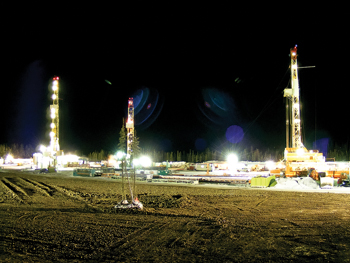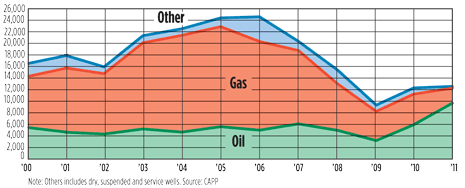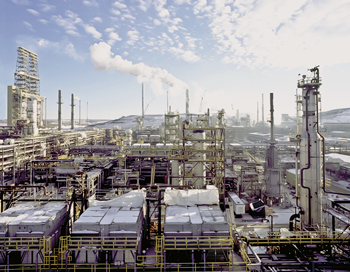ROBERT CURRAN, Contributing Editor, Canada
Stability has always been something that producers crave. On the oil side, prices have been both stable and bullish. But the type of stability that industry has seen on the natural gas side of the equation must make even the most optimistic company question whether it’s worth it. On top of that, industry must deal with increasing political interest, and influence, over its business. The production and shipping of oil has become a political hot potato.
Other indicators of the industry’s health paint a conflicting picture, as well. As gas prices fell to a 12-year low, land sale revenue hit a new all-time high in 2011. Drilling was steady, but a lack of skilled workers is limiting growth opportunities. The strong Canadian dollar continues to hamper export revenues.
 |
| Apache Corp. completed more than two dozen gas wells in British Columbia’s Horn River basin, and the firm will likely export some of that gas via the Kitimat LNG project that it plans to operate. |
|
 |
| Canadian wells drilled, 2000–2011 |
|
PIPELINE PROJECTS AFFECT E&P
One of the biggest wild cards is the political landscape. On the heels of U.S. President Obama’s rejection of the Keystone XL pipeline application, Canadian Prime Minister Stephen Harper reiterated his government’s pledge to seek out and develop other markets for Canadian crude. In January, at the World Economic Forum in Davos, Switzerland, Harper said his government would “make it a national priority to ensure we have the capacity to export our energy products beyond the United States, and specifically to Asia.” With world demand for crude increasing daily, most producers are confident that there will be a market for Canada’s crude oil, including production from the oil sands. It’s just a matter of finding the best way to get the crude to that market.
A federal hearing is underway to assess Enbridge Inc.'s C$5.5-billion (approximately C$1.00 = US$1.00) Northern Gateway pipeline project, which would ship crude from Alberta’s oil sands to British Columbia’s coast and, from there, to Asia. A decision from the panel is not expected before the end of 2013. A previous pipeline project that was stalled for years, due to lengthy regulatory processes, is the Mackenzie pipeline, which was proposed to ship gas from the Arctic south to the U.S. The pipeline received final approval in December 2010. Project proponents claim the elongated process added an additional C$3 billion to the price tag.
In the meantime, Canada’s Natural Resources Minister Joe Oliver has vowed to review the current regulatory system. He is concerned that certain groups (sometimes foreign-based) fund opposition that abuses and disrupts the system in an effort to delay projects to the point where companies give up because they’ve become economically unfeasible. Oliver has vowed to make changes as early as this year to streamline the federal regulatory process. Part of the issue stems from the willingness of pipeline and oil sands opponents to say just about anything to cast the industry in a negative light, regardless of whether or not their claims are true. Lately, Canadian politicians, industry associations and individual companies have stepped up their efforts to educate and counter the false statements made by special interest groups. Polling has consistently shown that most Canadians support the orderly development of all oil and gas resources.
PRICE OUTLOOK
In the meantime, and despite all the noise, Canadian exports of crude are projected to grow substantially over time, as the U.S. weans itself off non-North American foreign oil suppliers and supplants that supply with increased domestic production and Canadian imports. Crude oil from Alberta’s oil sands is expected to be the source of most of this production growth. This is good news for Canadian producers, as oil prices remain strong, and the outlook in the short-to-medium term is bullish on oil. Light sweet crude averaged C$95.16 per barrel in Alberta in 2011, the highest level recorded since the record-setting C$103.07 per barrel set in 2008.
Gas producers face a bleak short-term outlook. Prices are averaging C$3.45 per gigajoule (C$3.23/Mcf), the lowest level since 1999, when gas hit C$2.77/GJ (C$2.60/Mcf).
On the bright side, some analysts predict that the pace of global demand for gas will lead to price recovery–possibly this year–provided that producers can find a way to get the gas to markets where demand is growing the fastest, like Asia. It also depends on growth in Canada’s ability to liquefy enough volumes of gas that it can be shipped offshore. Numerous British Columbia LNG projects have been announced recently, although only one is set to be operational before 2020. Nonetheless, other analysts are more bearish. They call for natural gas prices to remain soft for the next several years.
SPENDING PLANS
The uneven pricing landscape is reflected in spending plans for 2012, as oil-focused producers are far more aggressive than those targeting gas. According to Calgary-based First Energy Capital, spending should reach C$67.3 billion this year, compared to C$62.5 billion in 2011. Oil sands spending is expected to reach a new annual high of C$18.5 billion.
Suncor Energy Inc. has once again announced an increase in spending, to C$7.5 billion in 2012, about 12% higher than in 2011. About 60% is earmarked for projects at the company's oil sands operations, while significant investments are also anticipated in offshore operations on Canada's East Coast and in the North Sea. With the Firebag Stage 3 expansion project now operational, the company is shifting its attention (and dollars) to the Firebag Stage 4 expansion project.
Canadian Natural Resources Ltd. will hike its spending to C$7.2 billion, compared to $6.0 billion in 2011. About $3.8 billion is ticketed for long-term developments, with $3 billion set aside for flexible spending. The company expects to see a production increase of 17% in 2012 as a result of its expenditures.
EnCana Corp., with its heavily gas production-weighted portfolio, once again appears to be reducing spending this year, to $US3.7 billion, although it has not yet released it final capital budget. The company continued to shift toward a more liquids-rich portfolio in 2011, and made several big-ticket divestitures, including acreage in the Barnett shale play. On the other side of the oil/gas equation resides EnCana’s sister company, Cenovus Energy Inc. The company’s 2012 capital budget of C$3.1–C$3.4 billion is about 23% higher than 2011 spending. The company expects oil production to grow in 2012, with its Christina Lake oil sands operation more than doubling average volumes over 2011. In addition, the next expansion at Christina Lake, phase D, is now anticipated to start producing by the end of 2012, several months ahead of schedule.
Talisman Energy Inc. said it will reduce North American spending by about C$400 million this year, to C$1.8 billion, due primarily to a shift away from dry gas. Over 40% of spending will focus on liquids-rich plays, including an increased focus on its South Texas Eagle Ford holdings, where spending is set to increase from C$350 million to C$500 million.
M&A ACTIVITY
The prolonged gas price slump has made many producers vulnerable to takeovers, although their gas-weighted production has also reduced interest in their assets. As a result, 2011 was relatively slow for mergers and acquisitions.
According to Calgary’s Sayer Energy Advisors, spending topped out at C$15.6 billion in 2011, down 56% from 2010’s C$35.5 billion, and the lowest level since 2004. Corporate transactions comprised 59% of the 2011 total, a reversal of the 2010 trend, when only 29% were corporate deals. Sayer expects the low M&A activity last year to rebound significantly in 2012, particularly as the prolonged low gas price environment has led to more consistent valuations of gas properties (and producers) by both buyers and sellers.
Last year, two acquisitions made by Chinese companies comprised almost 60% of corporate transactions. In October, Sinopec International Petroleum scooped up Daylight Energy Ltd. for C$3.2 billion. And in July, CNOOC Ltd., China’s largest offshore oil producer, paid C$2.1 billion to acquire troubled oil sands producer OPTI Canada Inc.
The Chinese have stepped into Canada again in early 2012, as Athabasca Oil Sands Corp. sold its remaining 40% interest in the MacKay River oil sands project to PetroChina for C$680 million. PetroChina now owns the project 100%.
DRILLING/PRODUCTION
Oil-targeted activity continued to drive Canadian drilling totals in 2011, with 8,282 oil wells drilled last year, or 64% of the total, according to Daily Oil Bulletin records. Overall, there were 12,877 wells drilled, a 6% increase from the 12,103 wells drilled in 2010. Horizontal drilling also continues to surge, leading to an increase of more than 25% in metres drilled last year. In 2011, just under 50% of all license permits granted were for wells employing horizontal drilling. The Canadian Association of Petroleum Producers (CAPP) said that 12,612 wells were drilled, up 2.2% from 12,343 wells in 2010.
In Alberta, the well count was basically unchanged, at 8,146, compared to 8,176 in 2010. Drilling activity in Saskatchewan increased 26% to 3,492 vs. 2,766 a year earlier. In B.C., the number of wells drilled dropped slightly, to 620 from 652. And Manitoba continues to see growth, with another annual record of 583 wells set in 2010, up almost 13% over the 518 wells drilled in 2010.
For 2012, the Canadian Association of Oilwell Drilling Contractors predicts that drilling will remain stable at 12,672 wells, with an average rig fleet utilization of 49%. The Petroleum Services Association of Canada is more bullish, calling for 13,350 wells this year, up about 4%. Last, but not least, CAPP forecasts 13,010 wells, a gain of 3.2%.
According to CAPP, Canadian oil production, including oil sands output, averaged 3.01 MMbpd, up 4.7% from 2010’s figure. The oil sands portion was about 1.656 million bopd. Active, conventional, producing oil wells totaled 66,585, of which 66.2% were on artificial lift. In addition, CAPP said that there were 10,800 in-situ wells producing oil. On the gas side, national output averaged 14.7 Bcfd. Active, producing gas wells numbered 125,898.
 |
| Suncor will push capital spending 12% higher during 2012, with about 60% of those expenditures going toward the firm’s oil sands operations. |
|
OIL SANDS
Despite all the hype, politics and smear campaigns (Editor’s note: much of it from environmentalists and the current U.S. administration) aimed at Canada’s enormous oil sands resource, business continues to thrive in northeastern Alberta. Imperial Oil Ltd.’s board recently gave the go-ahead to expand the Kearl oil sands mining project at a cost of C$8.9 billion. The expansion is expected to bring another 110,000 bpd onstream by 2015.
Last December, Total received final regulatory approval for its C$9 billion Joslyn North oil sands mine. Project partners on the 100,000-bopd project—scheduled to begin production in 2018—are Suncor, Occidental and Inpex.
Meanwhile, Husky Energy Inc. has said that it is on schedule for the C$2.5-billion Phase 1 of its 200,000-bopd Sunrise steam-assisted, gravity drainage (SAGD) oil sands project. Phase 1 will be capable of producing 60,000 bopd, and first oil is expected in 2014. Not all the news has been positive, however. ConocoPhillips has said that it may consider selling a portion of its Surmont, Thornberry, Clyden and Saleski oil sands holdings, as it continues to sell assets in an effort to reduce debt.
And the departure of two senior executives from Nexen Inc. has been linked by some observers to issues with the company’s troubled C$6.1-billion Long Lake project, which is operating well below its design capacity of 72,000 bopd. In late 2011, the company outlined a C$900-million drilling program that should bring production closer to capacity.
LAND SALES
One clear indication that long-term prospects are bright in Canada is 2011 land sale revenues, which topped the C$4-billion mark in western Canada for the third-highest total, all time. The record of $5 billion was set in 2008.
Producers spent C$4.13 billion last year, up 11% over C$3.73 billion in 2010. Alberta led the way by collecting C$3.64 billion, a new provincial record, and an increase of 51% over the C$2.41 billion spent in 2010. The previous record, C$3.43 billion, was set in 2006.
In British Columbia, land sales generated C$223 million, plummeting 73.6% from 2010's amount, the lowest total since 1999. To the west, Saskatchewan brought in its fourth-highest total ever, C$249 million, which still represented an 86% decrease from the C$463 million collected in 2010. Land inventories indicate future drilling activity, so any uptick in land sale volumes is a strong indicator that a recovery is underway in Canada. 
|
THE AUTHOR
|
| ROBERT CURRAN is a Calgary-based freelance writer with extensive industry experience. |
|





